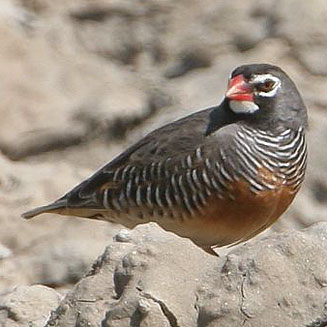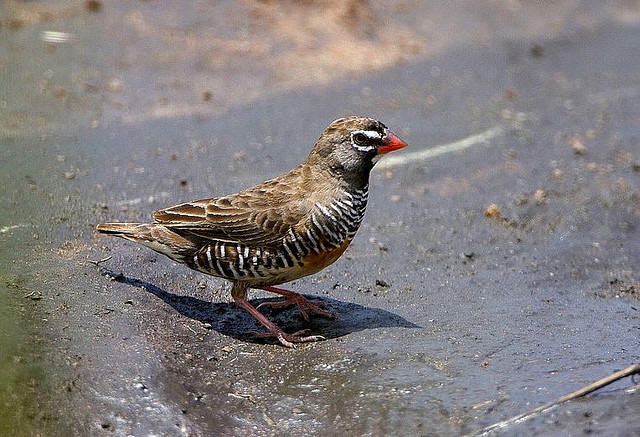
Ortygospiza atricollis
SUBFAMILY
Estrildinae
TAXONOMY
Fringilla atricollis Vieillot, 1817.
OTHER COMMON NAMES
English: Quailfinch, ground finch, partridge finch; French:
Astrild-caille а lunettes; German: Wachtelastrild; Spanish:
Astrilda Aperdizada.
PHYSICAL CHARACTERISTICS
3.7–3.9 in (9.5–10 cm). A short tail and lark-like legs are indicative
of this species’ terrestrial nature. Sexes slightly differ;
males have a black face and brown breast. Females are lighter
in these areas. Juveniles similar to the female but have fainter
barring and a darker bill.
DISTRIBUTION
Senegal east to western Cameroon. Southern Sudan to Angola
and south to South Africa.
HABITAT
Found in open areas with patchy grass growth, often near water,
including sandy grassland, marsh, farms and croplands, and
recently mowed areas.
BEHAVIOR
This shy species spends almost all of its time on the ground in
pairs or small flocks, being seen only when flushed, one of the
few reasons it ever takes flight. The call is a metallic “trillink”
or “chwillink” while the song is a series of “click, clack, cluck”
notes delivered rapidly and repeatedly.
FEEDING ECOLOGY AND DIET
Feeds on small grass seeds and on occasional spiders or insects.
REPRODUCTIVE BIOLOGY
A dome-shaped nest of grass stems and blades is built on the
ground. Four to six white eggs are incubated by both parents.
CONSERVATION STATUS
CITES: Appendix III. Not considered threatened by the IUCN.
SIGNIFICANCE TO HUMANS
Has appeared in aviculture in very low numbers in the past,
but is not a popular aviary subject, probably due to its shy and
flighty disposition.
Other popular Animals
Photo Gallery of - African quailfinch




 Animalia Life
Animalia Life